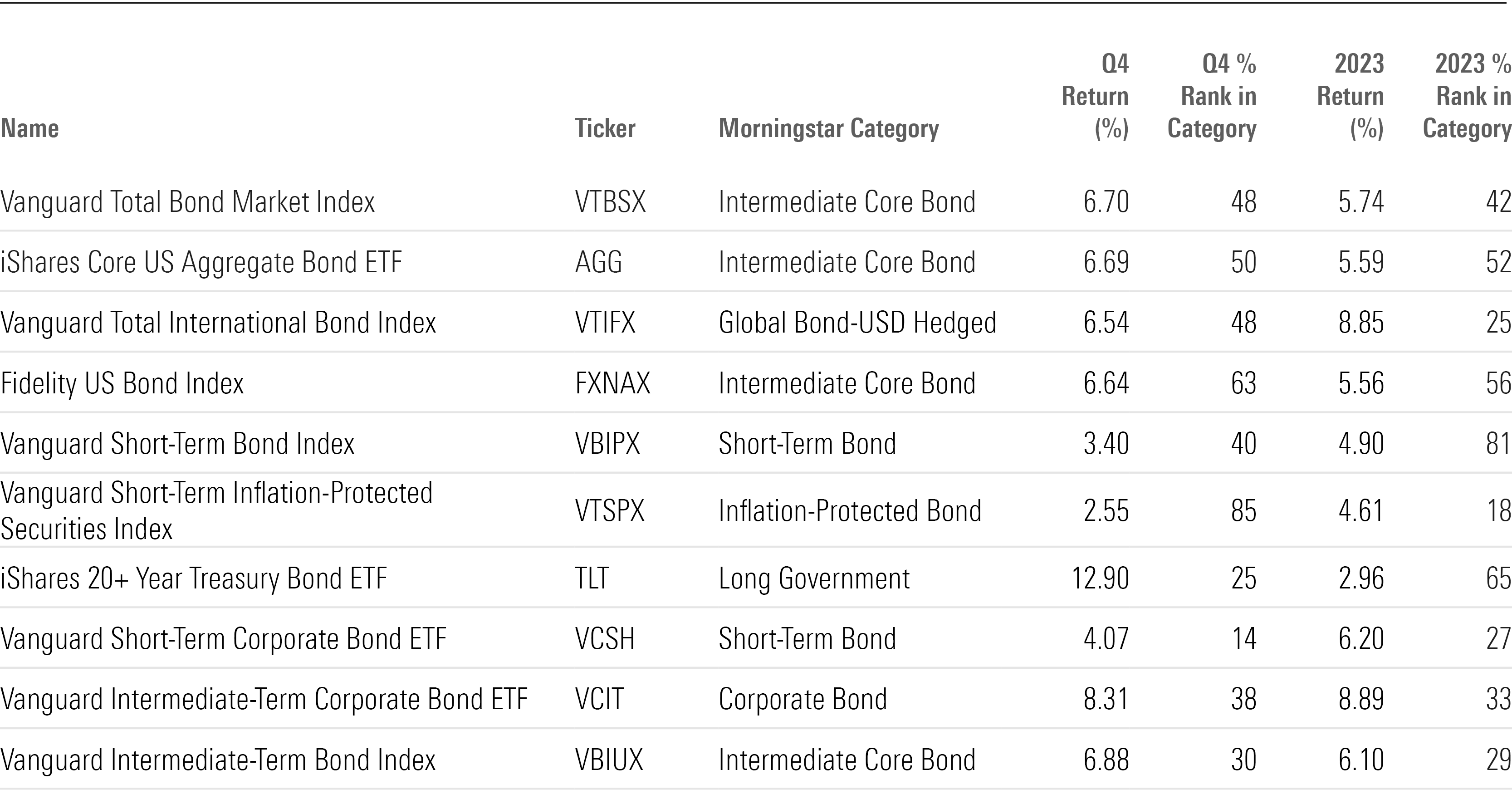How the Largest Bond Funds Did In 2023
Dodge & Cox Income, PGIM Total Return lead, while Vanguard Short-Term Bond lags.

After two years of losses, investors in the largest bond funds have reason to cheer.
Across the board, the most widely owned bond funds posted gains for 2023, avoiding what just a few months ago looked like an unprecedented third consecutive year in the red.
With the Federal Reserve’s “higher for longer” messaging on interest rates, intermediate and long-term bond funds particularly suffered. That includes the largest funds in the intermediate core bond category, which is widely used as a foundational building block for investor portfolios.
However, with Fed officials revealing that they expect to cut rates in 2024, bond funds rebounded 6.6% in the fourth quarter. According to Morningstar Direct, core bond funds have not posted a quarterly return that high since the late 1980s.
For example, the largest U.S. passive bond fund, the $302.3 billion Vanguard Total Bond Market Index fund VTBSX, gained 6.7% in the fourth quarter and 5.7% over the year. That compares to a 5.6% gain for the average intermediate core bond fund.
The largest active bond fund, the $131.6 billion Pimco Income PIMIX, gained 5.9% in the fourth quarter and 9.3% over the year—its best performance since 2012 and well above the 8.1% return on the average multisector bond fund. Morningstar director of manager research Eric Jacobson says that for much of the year, the fund benefited from income generated by its exposure to ultra-short-term rates.
Here’s a look at how the largest mutual and exchange-traded funds fared in 2023. Performance data for this article was based on the lowest-cost share class for each fund. Some funds may be listed with share classes not accessible to individual investors outside of retirement plans. The individual investor versions of those funds may carry higher fees, which reduces returns to shareholders.
2023 Performance: Largest U.S. Bond Index Funds
Among the largest passive funds, those focused on corporate bonds, such as the $44.8 billion Vanguard Intermediate-Term Corporate Bond ETF VCIT, posted the highest returns.
Investors came into 2023 with expectations of a recession, which would put companies at risk of defaulting on their debt. Instead, the U.S. economy gained strength throughout the year, and corporate bonds saw fewer credit rating downgrades and defaults than anticipated.
Long-term bond funds saw the lowest returns in 2023. The $51.4 billion iShares 20+ Year Treasury Bond ETF TLT gained only 3% on the year, despite surging 13% in the fourth quarter.
Largest Passive Bond Funds 2023 Performance

2023 Performance: Largest Active U.S. Bond Funds
Among active funds, multisector bond funds such as Pimco Income performed best in 2023. Among other categories, the $67.1 billion Dodge & Cox Income DOXIX posted a 7.8% return, outperforming over 90% of its peers in the intermediate core-plus bond category. The average fund in the category returned 6.2% in 2023.
“The strategy’s long-standing shorter-than-benchmark duration makes it less sensitive than its competitors to changes in interest rates,” says senior analyst Sam Kulahan. “This structural stance helps it hold up better than its benchmark and most peers when rates spike.”
The $80.2 billion American Funds Bond Fund of America RBFGX lagged its peers in the intermediate core bond category with a 5.1% return on the year. According to director of manager research Alec Lucas, “Most of the underperformance came in the second quarter due to a combination of the portfolio’s greater sensitivity to rising interest rates and yield-curve positioning.”
Largest Active Bond Funds 2023 Performance

Long-Term Performance Trends
Three-year performance for bond funds is largely negative, thanks to large losses suffered in 2022 as the Fed aggressively hiked interest rates.
Out of the largest bond funds, only two show positive three-year performances. The Vanguard Short-Term Inflation-Protected Securities Index VTSPX led the pack with a 2.3% annualized gain, benefitting from the outperformance of funds focused on shorter maturities. The average inflation-protected bond fund has lost 0.8% per year over the last three years.
According to associate manager research analyst Mo’ath Almahasneh, “Targeting short-term TIPS strengthens the fund’s sensitivity to inflation because short-term interest rates are more correlated with inflation than long-term rates. Additionally, the inflation protection embedded in the fund’s performance isn’t overshadowed by interest-rate risk.”
Pimco Income also holds a positive three-year return, posting a gain of 1.1% on an annualized basis, compared to an average return across the multisector category of 0.1% per year.
Five-year performance for bond funds is slightly better, with most posting returns between 1% and 2%. Again, the Vanguard Short-Term Inflation-Protected Securities Index and Pimco Income led with 3.3% and 3.4% returns, respectively. The only fund to post negative five-year returns is the iShares 20+ Year Treasury Bond ETF.
Largest Bond Funds Long-Term Performance

The author or authors do not own shares in any securities mentioned in this article. Find out about Morningstar’s editorial policies.

/s3.amazonaws.com/arc-authors/morningstar/11aca145-fc87-4ca5-9dbf-09f77ad3584c.png)
/cloudfront-us-east-1.images.arcpublishing.com/morningstar/FGC25JIKZ5EATCXF265D56SZTE.jpg)
/d10o6nnig0wrdw.cloudfront.net/04-25-2024/t_d30270f760794625a1e74b94c0d352af_name_file_960x540_1600_v4_.jpg)
/cloudfront-us-east-1.images.arcpublishing.com/morningstar/DOXM5RLEKJHX5B6OIEWSUMX6X4.png)
:quality(80)/s3.amazonaws.com/arc-authors/morningstar/11aca145-fc87-4ca5-9dbf-09f77ad3584c.png)